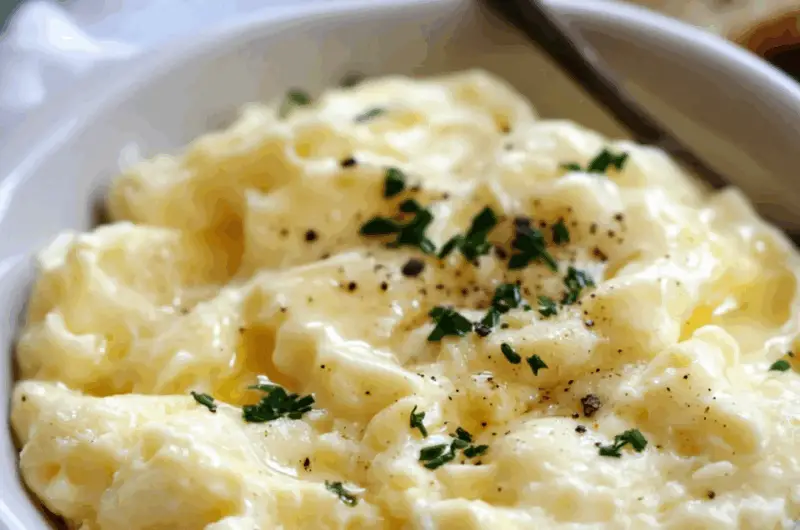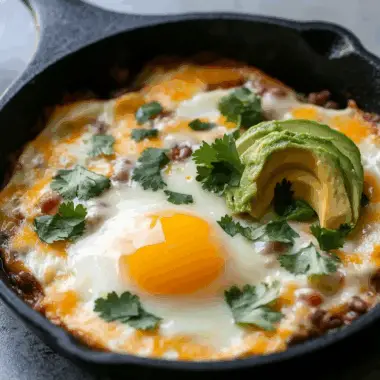French-Style Scrambled Eggs are a breakfast classic known for their soft, creamy texture. Unlike typical American scrambled eggs that are cooked quickly until firm, French-style eggs are cooked slowly over low heat in lots of butter, stirred constantly until small, soft curds form. The result is luxuriously creamy eggs that feel almost like a sauce. This method uses fresh, extra-large eggs whisked with cream and cooked gently to achieve that delicate texture.
Full Recipe:
Ingredients
-
8 eggs
-
4 tablespoons heavy cream or half and half
-
4 tablespoons (1/2 stick) unsalted butter, at room temperature
-
Salt and freshly ground pepper, to taste
-
4 tablespoons minced fresh chives and/or parsley
Directions
-
In a bowl, combine the eggs and cream. Whisk until fully combined with no visible whites.
-
In a non-stick skillet over low heat, melt 2 tablespoons of butter until foamy but not browned.
-
Pour in the eggs and stir continuously with a flexible spatula, scraping the bottom and edges of the pan, until the eggs begin to thicken and form small, soft curds. This should take about 10 minutes, and the eggs should be creamy. Remove from heat.
-
Cut the remaining 2 tablespoons of butter into small cubes and stir gently into the eggs until fully melted and incorporated.
-
Season with salt and pepper, garnish with chopped chives and/or parsley, and serve hot.
Approximate Nutritional Value (per serving, recipe serves 4):
-
Calories: ~250-300 kcal
-
Protein: 12-14 grams
-
Total Fat: 22-25 grams
-
Saturated Fat: ~13-15 grams
-
-
Cholesterol: ~350-400 mg
-
Carbohydrates: 2-3 grams
-
Fiber: 0 grams
-
Sugars: 1 gram or less
-
Sodium: ~150-200 mg (varies with added salt)
These values come mainly from eggs, butter, and cream, making this dish high in fat and protein, moderate in calories, and very low in carbs.
The Art of Slow Cooking Eggs
The defining feature of French-Style Scrambled Eggs lies in the gentle cooking process. Patience is key. Cooking the eggs over low heat and stirring continuously prevents them from drying out or forming large lumps. Instead, the eggs slowly thicken and create a creamy texture. This method mimics the approach used in classical French cooking where eggs are treated with the same respect as other delicate ingredients. The eggs almost seem to melt into themselves, resulting in a mouthfeel that is smooth and velvety rather than dry or rubbery.
The use of butter in this process is equally important. French chefs rely heavily on butter to add richness and to help create that signature silky texture. By melting the butter slowly and incorporating it both at the beginning and towards the end of cooking, the eggs gain a depth of flavor and a lush creaminess that is unmistakable.
Why Cream Matters
Adding cream or half and half to the eggs before cooking is a traditional touch that makes a big difference in the final outcome. The dairy helps to tenderize the eggs and keeps them moist throughout the slow cooking process. It also contributes to the smooth, luscious texture that defines French scrambled eggs. This addition sets them apart from typical scrambled eggs that might be made with just eggs and milk or no dairy at all.
Cream also adds a subtle sweetness and enhances the flavor profile, balancing the richness of the butter and eggs. This careful balance of ingredients ensures the dish isn’t just about texture but also about a harmonious and complex taste.
Cooking Technique and Tools
A key to success with this recipe is using the right pan and utensil. Non-stick skillets are preferred because they allow for gentle cooking without eggs sticking to the surface, which could ruin the delicate texture. A flexible spatula is ideal for constant stirring because it can easily scrape the sides and bottom of the pan without damaging the eggs.
The continuous stirring motion is almost meditative. It prevents the eggs from setting too quickly and encourages the formation of the small curds that are so characteristic of French scrambled eggs. The slow, steady heat combined with gentle agitation creates an even cook that is uniform throughout the dish.
Flavor and Presentation
Seasoning the eggs simply with salt and freshly ground pepper is the traditional approach. The goal is to enhance the natural flavors of the eggs and butter rather than overpower them. Fresh herbs like chives or parsley add a burst of freshness and a touch of color, making the dish visually appealing and aromatic. The herbs also provide a contrast to the richness, brightening the palate.
The eggs should be served immediately while still warm and creamy. If allowed to cool, they will continue cooking slightly from residual heat and may lose their desirable texture, becoming more firm and less luxurious.
Nutritional Considerations
French-Style Scrambled Eggs are a nutrient-dense dish. They provide a substantial amount of protein and fat, which makes them satisfying and filling. The fats come primarily from the butter and cream, which also contribute to the flavor and texture but make the dish rich and calorie-dense. For those monitoring fat intake, this dish is a decadent option best enjoyed in moderation.
Carbohydrates are very low, making this recipe suitable for low-carb and ketogenic diets. The dish is also gluten-free, naturally free from sugars, and offers moderate sodium levels depending on how much salt is added.
Versatility and Serving Suggestions
While French-Style Scrambled Eggs shine on their own as a breakfast item, they can be easily incorporated into more elaborate meals. They pair beautifully with toasted artisanal bread, smoked salmon, sautéed mushrooms, or a fresh green salad. For a brunch spread, they complement dishes like roasted tomatoes, bacon, or grilled asparagus.
Because of their creamy texture, these eggs also make a fantastic base for toppings. Adding crème fraîche, grated cheese, or a sprinkle of truffle oil can further elevate the dish. The richness also balances well with tart or acidic sides, such as fresh tomatoes or a citrus vinaigrette.
Culinary History and Cultural Significance
The technique behind French-Style Scrambled Eggs is rooted deeply in French culinary tradition, where respect for ingredients and attention to detail are paramount. Classic French cooking often involves slow, precise methods that bring out the best textures and flavors. This dish embodies that philosophy perfectly.
Though simple, the recipe requires patience and care, making it a favorite for those who appreciate the art of cooking. It’s a testament to how humble ingredients like eggs can be transformed into something special when handled correctly.
Conclusion
French-Style Scrambled Eggs are a remarkable departure from the quick, firm scrambled eggs many are familiar with. Their slow cooking process, generous use of butter, and addition of cream produce a dish that is creamy, delicate, and indulgent. This technique highlights the elegance achievable in simple ingredients and celebrates texture and flavor in every bite.
Ideal for a leisurely breakfast or an elegant brunch, these eggs bring a touch of French culinary sophistication to the table. Whether enjoyed on their own or paired with complementary dishes, they offer a luxurious start to any day. Mastering this technique not only improves your cooking skills but also enhances your appreciation for the subtleties of food preparation.
Incorporating French-Style Scrambled Eggs into your cooking repertoire invites you to slow down and savor the process, resulting in a rewarding and delicious breakfast experience.








